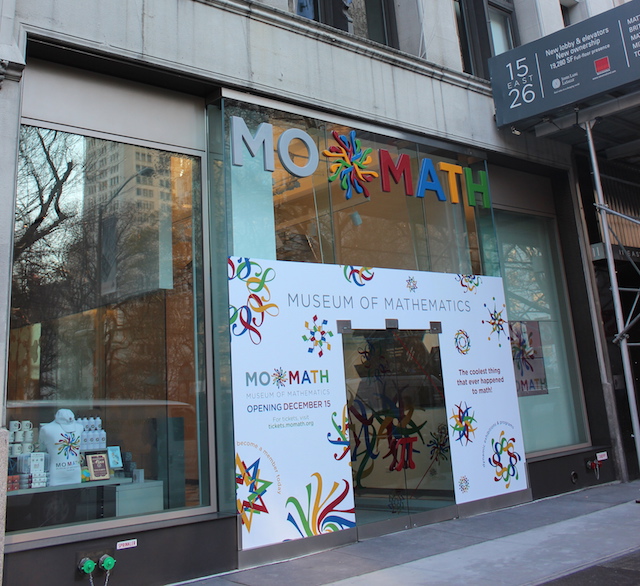

MoMath is up for the challenge of making math cool. Photo: Museum of Mathematics
I never did well in advanced mathematics at school. I was more of an English/Art student, and for some reason that was accepted. Glen Whitney, the hedge fund analyst turned founder and executive director of the first math museum in America, does not agree that math should be isolated as a subject. The Museum of Mathematics, or “MoMath” as it is lovingly nicknamed, shows that math is all around us. “Kids are born explorers,” Whitney says in a press release for the museum. “They ask questions about everything. Math is a ripe area for exploring patterns and asking questions, but kids can pick up a social message that math is weird. We want to send a message that it is cool to love math.”
With two floors and over 19,000 square feet, the museum certainly makes the case that math can be fun. Over spring break, my 5-year-old son and I spent a day at the museum with a visiting friend and her 10-year-old daughter (who, for the record, is actually into math at school). Visitors to this museum come at all ages, but the sweet spot is 4th through 8th graders. I expected challenging snoozy math puzzles, and maybe some historical references to mathematicians, but instead, we found an interactive playground that explored applied mathematics in a hands-on way.

MoMath uses actual rides to entice kids to learn about mathematical concepts. Photo: Meredith Craig de Pietro
Upon entering the museum, we noticed that the door handles were in the shape of Pi, which set the stage for our mathematical adventure. A giant rink dominates the first floor where our kids rode a 3-square-wheeled tricycle over a bumpy circular track, yet shockingly had a smooth ride. Did we have to know about catenary curves to enjoy the experience? Nope, but it was a teachable moment for those who are so inclined to dive deeper. This exemplifies all of the exhibits, which allow kids to engage in mathematical principals in a fun way, and give room to explore concepts in more detail if desired.
Next the kids descended on a platform surrounded by colorful cords. Swiveling on a chair makes the cables pull in, and twist around the chair axis. Another “ride” is the “Coaster Rollers,” where kids climb aboard a boat which rides over acorn-shaped foam rollers. Hastily, we jumped from game to game, spending hours exploring patterns, lasers, and high-tech video games.
Downstairs, we jumped and walked on an interactive floor grid that displayed full body mazes and puzzles, which changed every 15 minutes, and were challenging enough to keep the kids occupied and happily frustrated long after the game was over. Then, we found a puzzle room, where children (and many adults) sat at interactive tables working on classic puzzle games including pentominoes and tangrams. These were definitely geared toward older children, but my son had fun making up his own games with the block pieces. My son’s favorite exhibit was the musical instrument made of touchable spheres. This four-foot-tall glowing structure played chords and harmonies as he explored three-note chords. Finally, we came to the “Human Tree,” where kids can stand on a sensory mat and move their bodies to watch themselves replicated as trunks and tree branches. As they move their arms, the trees sway and morph. These kids stayed here until closing, unknowingly learning all about fractals.

This musical instrument is so much cooler than a drum set. Photo: Museum of Mathematics
With our heads swimming in mathematical concepts, we decided to explore the equation of child happiness by completing our day with gelato from Eataly. One long line of tourists divided by four scoops of coconut gelato on a sunny bench at Madison Square Park equals the perfect end to a happy day.
Museum of Mathematics, 11 E. 26th Street, NY 10010. Hours: Open 7 days a week from 10am- 5pm. Adult: $15, Children/ Seniors $9, . Phone: 212-542-0566
Eataly, 200 Fifth Avenue, NY 10010. Hours: Open 7 days a week from 10am-11pm
for a day at the museum.

